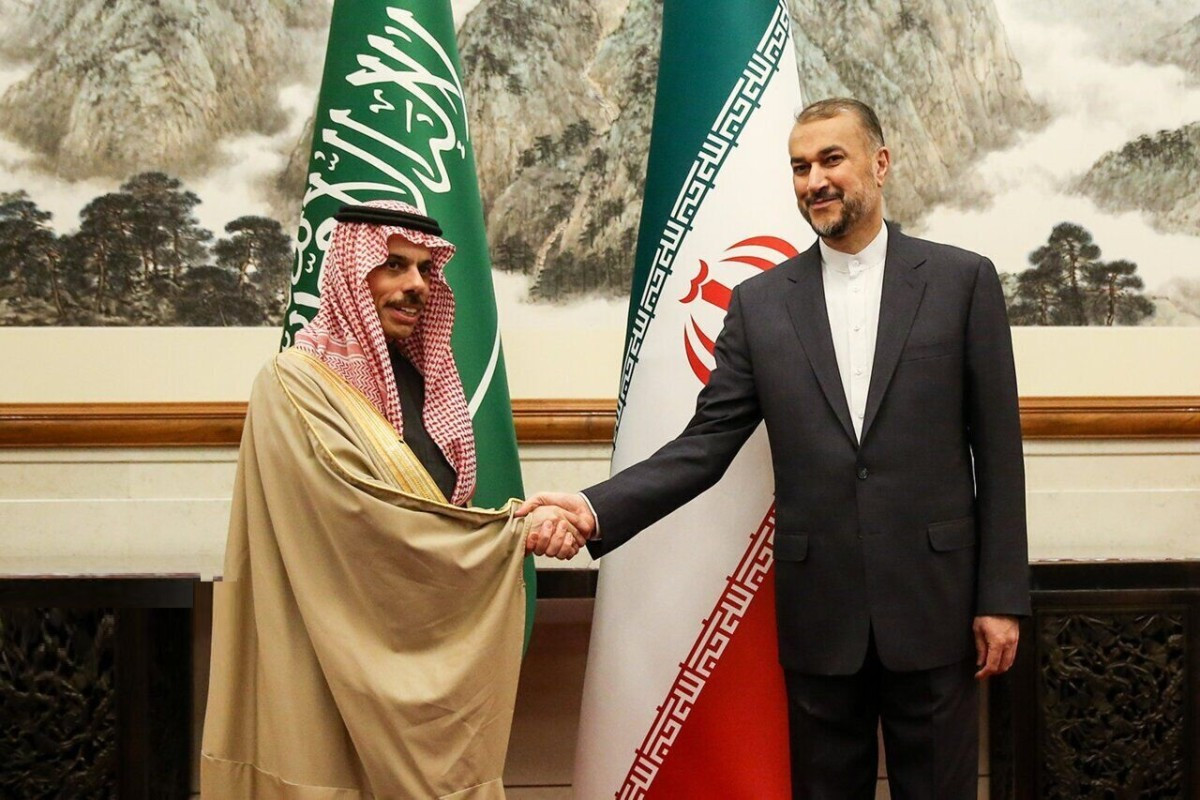Abdollahian's Visit to Saudi Arabia: The Ongoing Postponement of the Yemeni Issue
- 27 Sep 2023


Iranian Foreign Minister Hossein Amir Abdollahian's visit to Saudi Arabia concluded on August 18, 2023, following his meetings with Saudi Crown Prince Mohammed bin Salman in Jeddah and his Saudi counterpart, Prince Faisal bin Farhan, in Riyadh.
The primary focus of the visit revolved around discussions related to bilateral relations and matters of mutual interest. Notably, there was no explicit mention or direct engagement by the Iranian delegation regarding the Yemeni crisis, an issue of paramount importance to Saudi Arabia due to its strategic significance and the myriad economic and humanitarian implications it entails.
Calls for Iran's intervention to facilitate a resolution of the Yemeni crisis have been persistently made, particularly after the signing of the Beijing Agreement on March 10, which marked the resumption of diplomatic relations between Saudi Arabia and Iran. During Abdollahi's visit to Riyadh and Jeddah, these calls were reiterated. However, the Iranian response remained consistent: they regarded the Yemeni conflict as internal, emphasising that it constitutes a contentious issue primarily between Riyadh and Sanaa. This contention arose when the Houthi rebels seized control of Yemen, thereby overthrowing the internationally recognised government on September 21, 2014.
Numerous Factors
Undoubtedly, the assertions put forth by Iran are incongruent with the realities on the ground, where substantial evidence indicates that Iran wields the most significant influence within Yemen. This dominance is evident in various facets, ranging from the extensive provision of weaponry to offering strategic counsel during confrontations with rival factions and providing vital economic support to sustain governance in territories under Houthi control.
However, Iran consistently employs this rationale to rebuff any invitations to enlist its support in the ongoing efforts to resolve the Yemeni crisis. Three primary factors can elucidate this stance:
1- The Challenge of Yielding Ground in the Yemeni Quagmire: Active participation in bolstering efforts for a Yemeni conflict resolution necessitates Iran to make concessions, primarily due to its preeminent influence over the Houthi militia. The Houthi leadership invariably considers Iran its ultimate and sole patron, especially when making pivotal strategic decisions. Consequently, Iran faces considerable difficulty in making such concessions. This challenge is compounded by the realisation that it has already expended vast resources to fortify its presence in the Middle East region, with Yemen being a pivotal component. Rebuilding and replacing these investments would be no easy feat.
This predicament extends to other regions where Iran has cultivated influence, including Syria, Lebanon, and Iraq. Many Iranian factions contend that the influence amassed in these nations over recent years constitutes a potent leverage card against regional and international adversaries. In this perspective, as long as Iran has not yet reached a stage where it can manufacture nuclear weaponry—bearing in mind that such possession serves as a fundamental deterrent against potential adversaries—regional sway remains the linchpin of Iran's authentic deterrence. This influence cannot be readily substituted, especially as other regional and international powers oppose Iran's regional and nuclear ambitions.
Iran factors in numerous considerations here. A notable example is when the United States of America conducted a military operation in Baghdad on January 3, 2020, leading to the demise of Qassem Soleimani, the former commander of the Quds Force of the Revolutionary Guard. Iran's retaliatory response was also executed in Iraq through missile strikes at two American bases just five days later. This incident underscores how Iran's regional influence served as the enabling factor for responding to the assassination of one of its most prominent military leaders in the past four decades.
2- Evaluating the Boundaries of Saudi Policy Shift: All indications point to the Beijing Agreement signed on March 10, aimed at restoring diplomatic ties between Saudi Arabia and Iran, becoming a pivotal litmus test for potential shifts in Iranian foreign policy, particularly concerning various regional issues. Foremost among these issues is the Yemeni crisis. Iran, in response, perceives this agreement as a key gauge for assessing changes in Saudi policy, particularly regarding issues of particular interest to Iran.
Iran is meticulously monitoring and anticipating developments in Saudi policy on specific matters, notably the prospect of normalisation with Israel. Numerous reports suggest that the administration of US President Joe Biden is tirelessly striving to achieve this normalisation before the upcoming presidential elections next year. It's important to note that Saudi Arabia continues to assert that any such normalisation is contingent upon establishing a Palestinian state with East Jerusalem as its capital.
Iran steadfastly adheres to its long-standing approach since the inception of agreements normalising relations between Israel and various Arab states. Iran perceives itself as the primary target of these developments, as they bring Israel closer to its borders and tighten the regional encirclement around it. This is accomplished by strengthening relations with neighbouring nations, including Arab Gulf states like the United Arab Emirates and Bahrain, and countries like Azerbaijan and Turkmenistan, with which diplomatic ties have recently been established.
Iran is poised to contemplate substantial shifts in issues such as the Yemeni crisis. Still, it delays any decision until it gauges the impact of Saudi Arabia's evolving relations with Israel shortly. Although Iran acknowledges that major Arab countries, led by Saudi Arabia, have conveyed numerous messages to relevant global powers—chiefly the United States and Israel—expressing their disinclination to partake in any regional mobilisation aimed at countering Iran, this message emerged during US President Joe Biden's Middle East tour from July 13 to 16, 2022. Iran views this as a positive trend from those countries. Nonetheless, it also recognises that Israel remains resolute in its efforts to advance this agenda, even when Arab nations are careful to approach such ideas in a manner aligning with their national interests, regardless of whether these align with the calculations of their primary strategic ally, the United States of America.
3- Timing and the Unresolved Nexus of Issues: Iran's perspective leans towards the belief that the opportune moment for a comprehensive settlement has not yet materialised. In this context, a fundamental consideration underscores the interwoven nature of several complex issues that currently resist easy disentanglement. This intricate web of challenges makes it arduous to resolve one issue without the others becoming entrenched in an impasse.
Iran contends that engaging earnestly to reach a resolution in Yemen while simultaneously grappling with the escalating crisis surrounding its nuclear program vis-à-vis Western countries, notably the United States and Israel, runs counter to its immediate interests and strategic calculations.
According to Tehran's viewpoint, as long as these unresolved files remain open and tensions persist, a substantial breakthrough in the Yemeni crisis remains elusive. It is imperative, above all, to assess the trajectory of the ongoing tensions between Iran and the United States. This involves gauging the intersecting dynamics of mutual escalation measures before deciding on the Yemeni file.
At the same time, a notable prisoner exchange deal was announced between Iran and the United States on August 11. This deal entailed Iran releasing five American prisoners in exchange for the United States releasing Iranian detainees accused of violating American sanctions imposed on Iran. Additionally, Iran secured access to $6 billion of its frozen funds in South Korea. Despite these developments, both sides have maintained and fortified their respective escalation measures.
The United States bolstered its military presence in the Arabian Gulf region, deploying the destroyer USS Thomas Hudner and F-35 and F-16 fighter aircraft alongside a contingent of 3,000 soldiers. This move aimed to safeguard freedom of navigation in the Strait of Hormuz and prevent Iran from further detaining commercial vessels.
Concurrently, on August 20, approval was granted for the offloading of Iranian oil carried by the tanker "Suez Rajan," which had been detained by American authorities in adherence to sanctions against Iran—the value of this oil cargo amounts to approximately $56 million.
Contrarily, during the early days of August, Iran conducted military exercises near Abu Musa Island, showcasing its military prowess and unveiling new weaponry. Among the notable additions was the "Abu Mahdi" sea missile, boasting an impressive range of up to 600 kilometres. These manoeuvres were accompanied by overt threats directed towards the United States and Israel.
Maturation of a Resolution
In conclusion, Iran believes that resolving the Yemeni crisis remains elusive and contingent upon conditions and prerequisites not currently within reach. This assessment is made against the backdrop of the rapid and often conflicting developments in the contentious issues that hold particular significance for Iran.
As a result, Iran continues to adopt a strategy of "limited settlement." This strategy prioritises addressing humanitarian concerns, extending periods of calm, and resolving subsidiary disputes. A prime example of this approach is the heightened attention given to the salary issue, which currently occupies a prominent place on the agenda of the Houthi militia. Concurrently, Iran endeavours to leverage renewed threats emanating from the Houthi faction directed towards Saudi Arabia and the legitimate forces. These threats serve to underscore Iran's current approach to the Yemeni crisis.
The stated views express the views of the author and do not necessarily reflect the views of the Center or the work team.
Comments